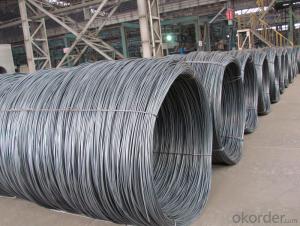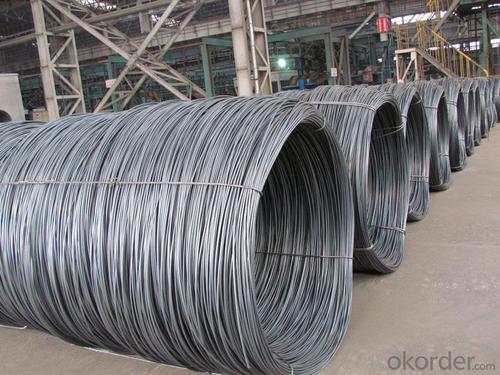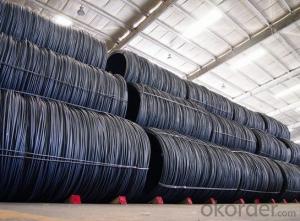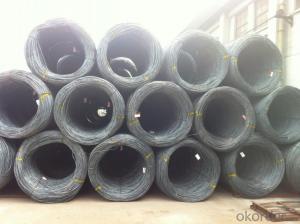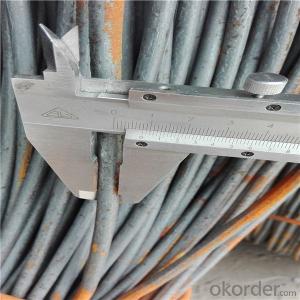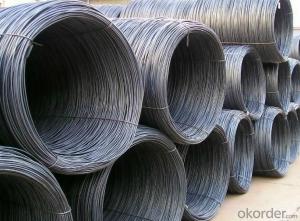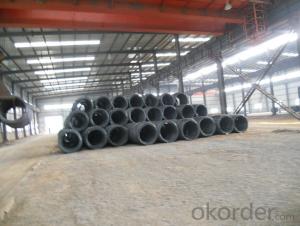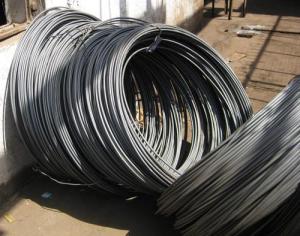Hot Rolled Wire Rod In Coil Round SAE1008
- Loading Port:
- Tianjin
- Payment Terms:
- TT OR LC
- Min Order Qty:
- 40 m.t.
- Supply Capability:
- 400000 m.t./month
OKorder Service Pledge
OKorder Financial Service
You Might Also Like
Steel Grade: SAE1008B
Standard: ASTM, GB
Diameter: 5.5mm, 6.5mm, 7mm,8mm,9mm,10mm,12mm,14mm
Type: Drawn Wire
Alloy or Not: Alloy
Technique: Hot Rolled
Place of Origin: China Mainland
Chemical Composition:
Please kindly find our chemistry of our material based on SAE1008B as below for your information
Grade | Chemical Composition (%) | |||||
C | Mn | S | P | Si | B | |
SAE1008B | 0.10max | 0.32max | 0.045max | 0.040max | 0.30max | 0.0008min |
Mechanical properties | ||||||
Yield strength(N/mm2) | Tensile strength(N/mm2) | Elongation (%) | ||||
≥195 | 350-380 | ≥32 | ||||
Usage and Applications:
After hot-rolled the products shaped into coil and delivery as finished product, including round, square, rectangular, hexagonal and so on. Since most of the products are round, it is generally called wire rod. Carbon steel wire rod is widely used in construction and manufacturing. Carbon steel wire rod is mainly used for reinforcement of reinforced concrete and welded structure or reprocessed (roberts , nail, etc.) materials, especially used to produce wire drawing, welding electrode, nails, spring, electronic, precise machinery parts and so on.
Process
1-Furnace 2-Roughing Mill 3-High-speed Finishing Mill 4-Water-cooled Device 5-Coiling Device 6-Cooling Device 7-Chain Conveyer 8-Spool Collecting Device 9-Spool Down Device 10-Hook Conveyer
Packaging & Delivery of Wire Rod SAE1008B:
Packaging Detail: products are packed in coil and then shipped by container or bulk vessel
Each coil weight: 2-3MT
Delivery Detail: within 45 days after received deposit or LC.
Label: to be specified by customer, generally, each bundle has 1-2 labels
Trade terms: CFR, CIF
Note:
1. Our products are produced according to national standard (GB), if not, supply according to national standards (GB) or agreement as customer required.
2. Other Grade and Standard carbon steel wire rod we can supply:
Grade: H08A, 30MnSi, 62B-82B
Standard: AISI, BS, JIS, DIN
The Minimum Order Quantity of these products is high, and need to be confirmed.
3. We can not only supply carbon steel wire rod; if you need anything about building materials, please contact us.
4. Please send us your detail specifications when inquire. We will reply to you as soon as possible. We sincerely hope we can establish a long stable business relationship.
- Q: What are the requirements for steel wire rod used in cable-stayed bridge wire strands?
- The requirements for steel wire rod used in cable-stayed bridge wire strands include high tensile strength, excellent fatigue resistance, and good ductility. The wire rod should have a uniform and consistent diameter, along with a smooth surface finish to ensure optimal performance and durability. Additionally, it should meet specific chemical composition and mechanical properties standards set by the relevant engineering and construction codes. Thorough testing and certification processes are also necessary to ensure the quality and reliability of the wire rod used in cable-stayed bridge wire strands.
- Q: What are the common applications of alloy steel wire rod?
- Common applications of alloy steel wire rod include the manufacturing of automotive parts, construction materials, machinery components, and electrical equipment. It is also used in the production of springs, cables, wire mesh, and various types of fasteners.
- Q: What are the common production processes for xenon-coated steel wire rod?
- The common production processes for xenon-coated steel wire rod typically involve a series of steps including cleaning the wire rod, applying a primer coating, curing the primer, applying the xenon coating, and finally curing the xenon coating. These processes are crucial to ensure a durable and corrosion-resistant finish on the steel wire rod.
- Q: How is steel wire rod priced in the market?
- Various factors influence the pricing of steel wire rod in the market. These factors encompass the production and demand aspects. The cost of raw materials, such as iron ore and scrap metal, as well as the expenses associated with energy and labor during the manufacturing process, contribute to the pricing. Furthermore, the price of steel wire rod is influenced by market conditions, supply and demand dynamics, and additional factors. Global economic conditions, trade policies, and infrastructure development projects are some of the elements that can affect the demand for steel wire rod, thereby impacting its price. Steel wire rod is commonly traded on commodity exchanges, where participants engage in buying and selling contracts based on future delivery dates. The price of steel wire rod on these exchanges is influenced by market speculation, storage costs, and transportation expenses. Moreover, the price of steel wire rod is determined by its quality and specifications. Different grades, sizes, and coatings of steel wire rod have varying prices based on their suitability for diverse applications and industries. In conclusion, the pricing of steel wire rod is determined by a combination of factors, including raw material costs, production expenses, market conditions, supply and demand dynamics, quality specifications, and trading activities on commodity exchanges.
- Q: How does steel wire rod compare to other materials, such as aluminum or copper?
- Steel wire rod is comparably stronger and more durable than materials such as aluminum or copper. Steel has a higher tensile strength, making it better suited for applications that require high strength and resistance to bending or stretching. Additionally, steel wire rod is generally more cost-effective and widely available compared to aluminum or copper, making it a preferred choice in various industries including construction, automotive, and manufacturing.
- Q: How are steel wire rods stored to prevent corrosion?
- Steel wire rods are typically stored in a controlled environment, such as a warehouse, where proper temperature and humidity levels are maintained. They are often coated with a protective layer, such as rust-inhibiting oil or a corrosion-resistant coating, to prevent direct contact with moisture. Additionally, steel wire rods may be stored on pallets or racks, ensuring they are kept off the ground and away from any potential sources of moisture. Regular inspections and maintenance are also conducted to identify and address any signs of corrosion promptly.
- Q: What are the different types of steel wire rod processing equipment?
- There are several types of steel wire rod processing equipment, including wire drawing machines, wire straightening and cutting machines, wire mesh welding machines, and wire bending machines. Each of these equipment serves a specific purpose in the production and processing of steel wire rods, such as enhancing the wire's strength, straightening and cutting it to desired lengths, welding wires to create mesh structures, or bending them into various shapes.
- Q: What are the different surface protection materials used for steel wire rod?
- Steel wire rods can be protected using various surface protection materials. These materials are applied to the wire rod's surface to prevent corrosion and other forms of damage. One commonly used surface protection material for steel wire rods is zinc coating. This involves immersing the wire rod in a hot-dip galvanizing process, which results in a layer of zinc on its surface. Zinc acts as a highly effective corrosion inhibitor and creates a protective barrier between the steel and its environment. This coating is typically used for wire rods that will be exposed to harsh or corrosive conditions. Polymer coating is another surface protection material for steel wire rods. It can be applied using different methods like extrusion or dip coating. These coatings serve as a barrier against moisture, chemicals, and abrasion, effectively preventing corrosion and prolonging the wire rod's lifespan. Polymer coatings are commonly used for wire rods in indoor or outdoor applications that require corrosion resistance. Phosphate coating is a surface protection material that involves immersing the wire rod in a phosphate solution, resulting in a thin phosphate layer on its surface. This coating enhances adhesion for subsequent coatings or paints and offers some corrosion resistance. It is often used as a pre-treatment before applying other surface protection materials. Lastly, epoxy coating is a widely used surface protection material for steel wire rods. It is typically applied through electrostatic spray deposition. Epoxy coatings provide excellent corrosion resistance, chemical resistance, and durability. They are commonly used for wire rods exposed to harsh environments like marine or industrial applications. In conclusion, various surface protection materials, including zinc coating, polymer coating, phosphate coating, and epoxy coating, can be applied to steel wire rods. The selection of these materials depends on the specific requirements of the wire rod and its intended application.
- Q: How is steel wire rod tested for resistance to crevice corrosion?
- Steel wire rod is tested for resistance to crevice corrosion through various methods, including visual inspection, weight loss measurement, electrochemical testing, and exposure to corrosive environments. These tests help determine the susceptibility of the steel wire rod to crevice corrosion, which is crucial for ensuring its durability and performance in different applications.
- Q: What are the main factors influencing the supply and demand of steel wire rod?
- There are various primary factors that affect the supply and demand of steel wire rod. 1. Economic expansion: The general economic growth of a nation or region plays a significant role in determining the demand for steel wire rod. As the economy expands, there is typically an increase in construction and infrastructure projects, which drives up the demand for steel wire rod. 2. Construction and infrastructure ventures: The construction industry is one of the major consumers of steel wire rod. The demand for steel wire rod is influenced by the quantity and size of construction and infrastructure projects, such as buildings, bridges, roads, and railways. The greater the number of construction projects, the higher the demand for steel wire rod. 3. Automotive sector: The automotive industry is another major consumer of steel wire rod. The demand for steel wire rod in this industry is influenced by factors such as consumer demand for automobiles, technological advancements, and government regulations related to automotive safety and emissions. The production of automobiles requires steel wire rod for various components, including suspension systems, engine parts, and reinforcements. 4. Manufacturing domain: The demand for steel wire rod is also influenced by the overall manufacturing sector. Steel wire rod is used in various manufacturing processes and industries, such as machinery, appliances, electrical equipment, and furniture. The level of manufacturing activity and the demand for goods produced by these industries affect the demand for steel wire rod. 5. Availability and cost of raw materials: The supply of steel wire rod is influenced by the availability and cost of raw materials, particularly iron ore and scrap metal. Changes in the availability or cost of these raw materials can impact the production and supply of steel wire rod. Additionally, fluctuations in energy prices, transportation costs, and other input costs can also affect the supply of steel wire rod. 6. International trade and tariffs: Global supply and demand for steel wire rod are influenced by international trade and tariffs. Trade policies and tariffs imposed by countries can impact the import and export of steel wire rod, which in turn affects the supply and demand dynamics. Trade disputes and protectionist measures can disrupt the global steel wire rod market and create uncertainties in supply and demand. In summary, the supply and demand of steel wire rod are influenced by economic growth, construction and infrastructure ventures, the automotive sector, the manufacturing domain, availability and cost of raw materials, and international trade and tariffs. These factors interact with each other and can fluctuate over time, resulting in changes in the supply and demand dynamics of steel wire rod.
Send your message to us
Hot Rolled Wire Rod In Coil Round SAE1008
- Loading Port:
- Tianjin
- Payment Terms:
- TT OR LC
- Min Order Qty:
- 40 m.t.
- Supply Capability:
- 400000 m.t./month
OKorder Service Pledge
OKorder Financial Service
Similar products
Hot products
Hot Searches
Related keywords
